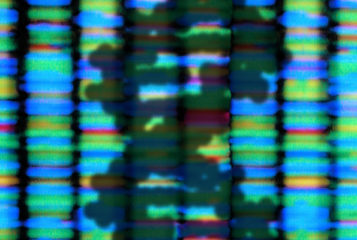Over 100 million genetic changes have been found in a single tumour, according to a new study.
Scientists at the University of Chicago and the Beijing Institute of Genomics have used rigorous genetic analysis techniques to conclude that cancer cells may have many more mutations than previously thought. Mutations in cancer cells are associated with drug resistance (see BioNews 827), and the authors say that the findings could explain how and why cancers develop resistance to treatment.
Chung-I Wu, professor of ecology and evolution at the University of Chicago, and one of the study's lead authors, said: 'With 100 million mutations, each capable of altering a protein in some way, there is a high probability that a significant minority of tumour cells will survive, even after aggressive treatment.
'In a setting with so much diversity, those cells could multiply to form new tumours, which would be resistant to standard treatments.'
In the study, published in PNAS, scientists took a slice of a single human liver tumour, about 35mm in diameter. They took 286 samples of around 20,000 cells, each from different places in the slice, and analysed the genetic code to find differences from the genomes of healthy cells.
From their results, they estimated that over 100 million mutations were present in the tumour — far more than previous estimates of up to 20,000 generally thought to exist in a single cancer. These mutations were present in 'coding sequences', which tell the cell how to assemble proteins.
They also found that at least 99 percent of the mutations were very rare in the tumour, present in the genomes of fewer than 100 cells. These cells were often in close proximity to each other.
The group also says that its findings indicate that mutations in tumour cells arise and spread in a more random way than prevailing theories suppose. Previously, it has been assumed that when a mutation appears which helps the cancer to survive, the cells carrying this mutation spread through a tumour by out-competing neighbouring cells.
However, this process would be expected to reduce the genetic diversity of a population, as cells with less suitable mutations would be replaced, inconsistent with the large number of mutations found in this study. The authors write that the small groups of cells expressing rare mutations are 'competing mostly with themselves' and cannot spread through the structure of a solid tumour.
Previous studies have shown that survival rates are reduced if a cancer is very genetically diverse. The authors conclude that their findings show that even small tumours could have very high genetic diversity, and write that this 'suggests a need to re-evaluate treatment strategies.'
Sources and References
-
New Data Suggest Extreme Genetic Diversity of Tumors May Impart Drug Resistance
-
Darwinian Selection Does Not Influence Tumor Progression
-
Extremely high genetic diversity in a single tumor points to prevalence of non-Darwinian cell evolution
-
100 Million Mutations May Shield Tumors From Treatment
-
Enormous genetic variation may shield tumors from treatment




Leave a Reply
You must be logged in to post a comment.